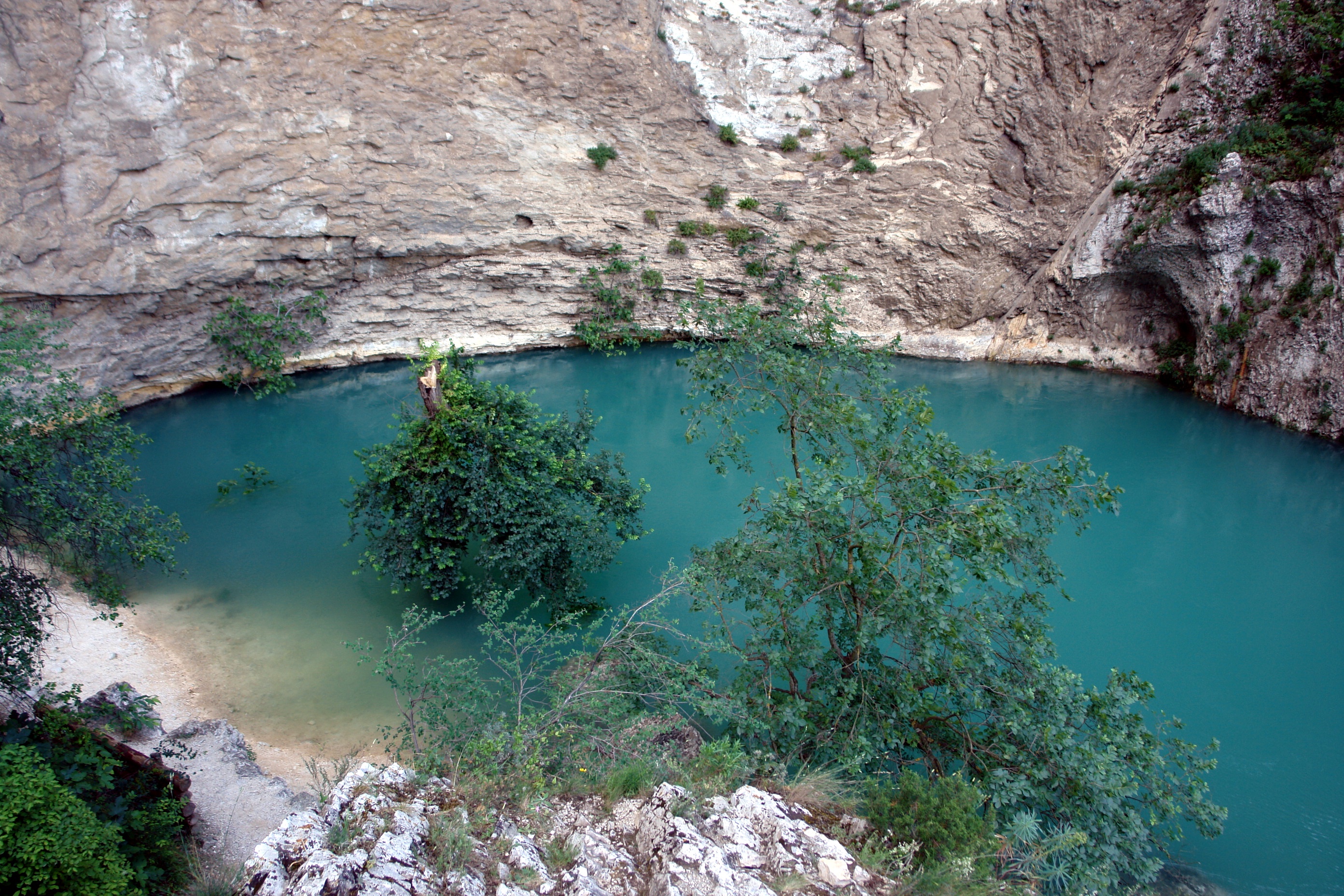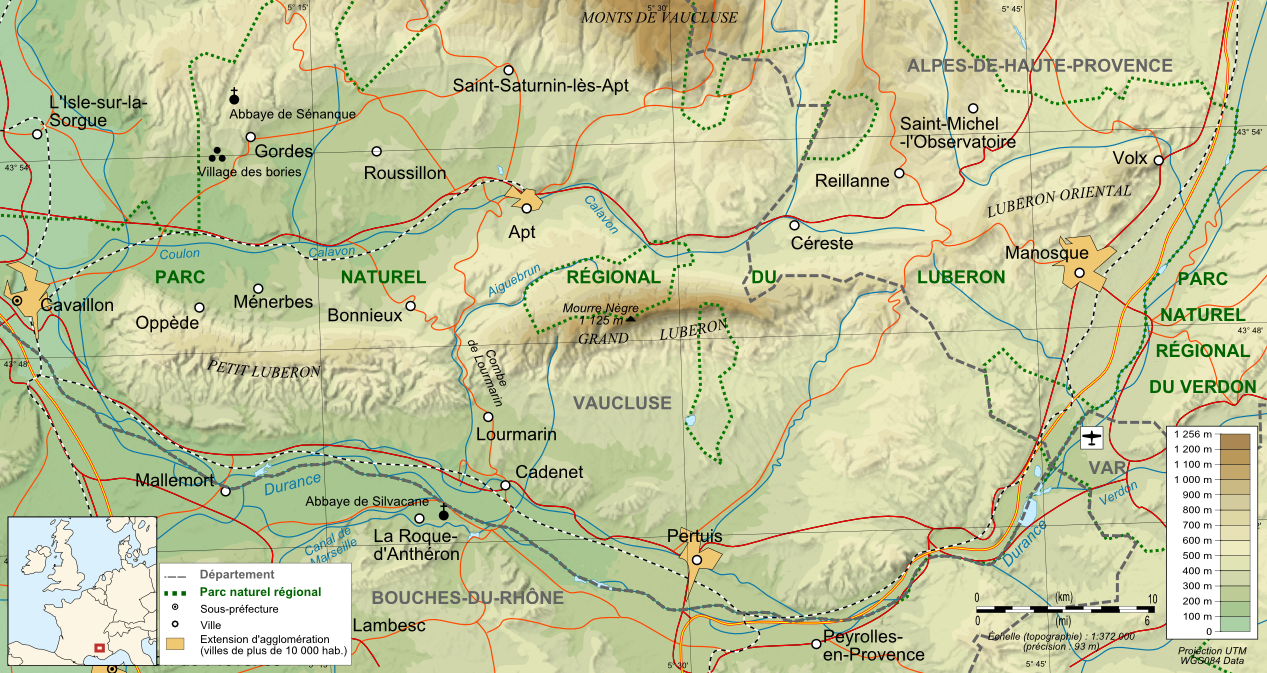|
La Tour-d'Aigues
La Tour-d'Aigues (; ) is a commune in the Vaucluse department in the Provence-Alpes-Côte d'Azur region, Southeastern France. Geography The town is located at the south of the Grand Luberon, away from Pertuis. It is the capital town of the Pays d'Aigues. Climate La Tour d'Aigues is under the influence of the Mediterranean climate characterised by hot and dry summers and mild winters. History Middle Ages The town belonged to the counts of Forcalquier until the end of the 12th century, when it passed to the Sabran family through marriage, and later to the Agoults. La Tour d'Aigues was partly destroyed in 1390 when facing the assault of Raymond VIII de Turenne. In addition to this, epidemics emptied the town of its population. This crisis allowed Fouquet d'Agoult to acquire new territories: le Tourel, la Bastidonne, Saint-Martin-de-la-Brasque, and Cabrière d'Aigues. The Templars also had an establishment at La Tour d'Aigues. Renaissance Raymond d'Agoult, Fouquet d'Agoult's ... [...More Info...] [...Related Items...] OR: [Wikipedia] [Google] [Baidu] |
Communes Of France
A () is a level of administrative divisions of France, administrative division in the France, French Republic. French are analogous to civil townships and incorporated municipality, municipalities in Canada and the United States; ' in Germany; ' in Italy; ' in Spain; or civil parishes in the United Kingdom. are based on historical geographic communities or villages and are vested with significant powers to manage the populations and land of the geographic area covered. The are the fourth-level administrative divisions of France. vary widely in size and area, from large sprawling cities with millions of inhabitants like Paris, to small hamlet (place), hamlets with only a handful of inhabitants. typically are based on pre-existing villages and facilitate local governance. All have names, but not all named geographic areas or groups of people residing together are ( or ), the difference residing in the lack of administrative powers. Except for the Municipal arrondissem ... [...More Info...] [...Related Items...] OR: [Wikipedia] [Google] [Baidu] |
Miscellaneous Left
Miscellaneous left (', ''DVG'') in France refers to left-wing candidates who are not members of any party or a member of party that has no elected seats. They include either small left-wing parties or dissidents expelled from their parties for running against their party's candidate. Numerous ' candidates are elected at a local level, and a smaller number at the national level. See also * Independent Democrat, a label used in the United States for an independent candidate who loosely identifies with the ideals of the Democratic Party but is not a formal member of the party *Miscellaneous centre *Miscellaneous right Miscellaneous right (', ''DVD'') in France refers to centre-right or right-wing candidates who are not members of any large party. This can include members of small right-wing parties, dissidents expelled from their party for running against thei ... References Left-wing parties in France Political parties of the French Fifth Republic Independent politicia ... [...More Info...] [...Related Items...] OR: [Wikipedia] [Google] [Baidu] |
Vaucluse
Vaucluse (; or ) is a department in the southeastern French region of Provence-Alpes-Côte d'Azur. It had a population of 561,469 as of 2019.Populations légales 2019: 84 Vaucluse INSEE The department's is . It is named after a spring, the Fontaine de Vaucluse, one of the largest karst springs in the world. The ... [...More Info...] [...Related Items...] OR: [Wikipedia] [Google] [Baidu] |
Departments Of France
In the administrative divisions of France, the department (, ) is one of the three levels of government under the national level ("territorial collectivity, territorial collectivities"), between the Regions of France, administrative regions and the Communes of France, communes. There are a total of 101 departments, consisting of ninety-six departments in metropolitan France, and five Overseas department and region, overseas departments, which are also classified as overseas regions. Departments are further subdivided into 333 Arrondissements of France, arrondissements and 2,054 Cantons of France, cantons (as of 2023). These last two levels of government have no political autonomy, instead serving as the administrative basis for the local organisation of police, fire departments, and, in certain cases, elections. Each department is administered by an elected body called a departmental council (France), departmental council ( , ). From 1800 to April 2015, these were called gene ... [...More Info...] [...Related Items...] OR: [Wikipedia] [Google] [Baidu] |
Provence-Alpes-Côte D'Azur
Provence-Alpes-Côte d'Azur (commonly shortened to PACA), also known as Région Sud, is one of the eighteen Regions of France, administrative regions of France, located at the far southeastern point of the Metropolitan France, mainland. The main Prefectures in France, prefecture and largest city is Marseille, France's third largest city after Paris and Lyon and the 2nd largest urban area when combined with Aix-en-Provence with slightly less than one million residents. History The region is roughly coterminous with the former Provinces of France, French province of Provence, with the addition of the following adjacent areas: the former Pope, papal territory of Avignon, known as Comtat Venaissin; the former Kingdom of Sardinia, Sardinian-Piedmontese County of Nice annexed in 1860, whose coastline is known in English as the French Riviera and in French as the ''Côte d'Azur''; and the southeastern part of the former French province of Dauphiné, in the French Alps. Previously known ... [...More Info...] [...Related Items...] OR: [Wikipedia] [Google] [Baidu] |
Regions Of France
France is divided into eighteen administrative regions (, singular ), of which thirteen are located in metropolitan France (in Europe), while the other five are overseas regions (not to be confused with the overseas collectivities, which have a semi-autonomous status). All of the thirteen metropolitan administrative regions (including Corsica ) are further subdivided into two to thirteen administrative departments, with the prefect of each region's administrative centre's department also acting as the regional prefect. The overseas regions administratively consist of only one department each and hence also have the status of overseas departments. Most administrative regions also have the status of regional territorial collectivities, which comes with a local government, with departmental and communal collectivities below the regional level. The exceptions are Corsica, French Guiana, Mayotte and Martinique, where region and department functions are managed by single l ... [...More Info...] [...Related Items...] OR: [Wikipedia] [Google] [Baidu] |
France
France, officially the French Republic, is a country located primarily in Western Europe. Overseas France, Its overseas regions and territories include French Guiana in South America, Saint Pierre and Miquelon in the Atlantic Ocean#North Atlantic, North Atlantic, the French West Indies, and List of islands of France, many islands in Oceania and the Indian Ocean, giving it Exclusive economic zone of France, one of the largest discontiguous exclusive economic zones in the world. Metropolitan France shares borders with Belgium and Luxembourg to the north; Germany to the northeast; Switzerland to the east; Italy and Monaco to the southeast; Andorra and Spain to the south; and a maritime border with the United Kingdom to the northwest. Its metropolitan area extends from the Rhine to the Atlantic Ocean and from the Mediterranean Sea to the English Channel and the North Sea. Its Regions of France, eighteen integral regions—five of which are overseas—span a combined area of and hav ... [...More Info...] [...Related Items...] OR: [Wikipedia] [Google] [Baidu] |
Luberon
The Luberon ( or ; Provençal dialect, Provençal: ''Leberon'' or ''Leberoun'' ) is a massif in central Provence in Southern France, part of the French Prealps. It has a maximum elevation of and an area of about . It is composed of three mountain ranges (from west to east): Lesser Luberon (''Petit Luberon''), Greater Luberon (''Grand Luberon'') and Eastern Luberon (''Luberon oriental''). The valleys north and south of them contain a number of towns and villages as well as agricultural land; the northern part is marked by the Calavon, while the southern part is characterised by the Durance. The Luberon is often advertised under the name Lubéron (with an acute accent on top of the "e"); some dictionaries justify that the two spellings are interchangeable. The total number of inhabitants varies greatly between winter and summer, due to a massive influx of tourists during the warm season. It is a favourite destination for French high society and British and American visitors becaus ... [...More Info...] [...Related Items...] OR: [Wikipedia] [Google] [Baidu] |
Pertuis
Pertuis (; ) is a Communes of France, commune in Vaucluse, a Departments of France, department in the southeastern Provence-Alpes-Côte d'Azur region of France, south of the Luberon. Pertuis has existed since at least 981, and a castle was first built in the 12th century. Population The population has tripped since the 1960s. International relations Pertuis is Twin towns and sister cities, twinned with: * Alton, Hampshire, England * Herborn (Hesse), Herborn, Hesse, Germany * Este, Veneto, Italy * Utiel, Spain Notable people from Pertuis * Victor de Riqueti, marquis de Mirabeau (1715–1789), economist * Michèle Torr (1947-), singer * Cyril Rool (1975-), footballer Gallery File:Église Saint-Nicolas de Pertuis, Vaucluse, France - 20090509.jpg, Église Saint-Nicolas See also *Communes of the Vaucluse department References External links Official websiteThe portal website Communes of Vaucluse {{Vaucluse-geo-stub ... [...More Info...] [...Related Items...] OR: [Wikipedia] [Google] [Baidu] |
Mediterranean Climate
A Mediterranean climate ( ), also called a dry summer climate, described by Köppen and Trewartha as ''Cs'', is a temperate climate type that occurs in the lower mid-latitudes (normally 30 to 44 north and south latitude). Such climates typically have dry summers and wet winters, with summer conditions being hot and winter conditions typically being mild. These weather conditions are typically experienced in the majority of Mediterranean-climate regions and countries, but remain highly dependent on proximity to the ocean, altitude and geographical location. The dry summer climate is found throughout the warmer middle latitudes, affecting almost exclusively the western portions of continents in relative proximity to the coast. The climate type's name is in reference to the coastal regions of the Mediterranean Sea, which mostly share this type of climate, but it can also be found in the Atlantic portions of Iberia and Northwest Africa, the Pacific portions of the United States ... [...More Info...] [...Related Items...] OR: [Wikipedia] [Google] [Baidu] |





